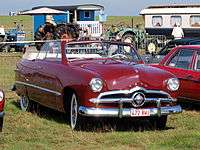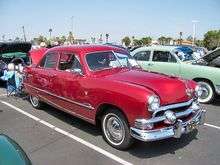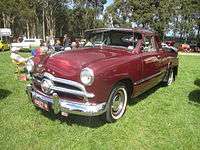1949 Ford
The 1949 Ford was an American automobile produced by Ford since 1948. It was the first all-new automobile design introduced by the Big Three after World War II, civilian production having been suspended during the war, and the 1946-1948 models from Ford, GM, and Chrysler being updates of their pre-war models. Popularly called the "Shoebox Ford" for its slab-sided, "ponton" design, the 1949 Ford is credited both with saving Ford and ushering in modern streamlined car design with changes such as integrated fenders and more. This design would continue through the 1951 model year, with an updated design offered in 1952. The crest was designed by Frank L. Engle.[4]
| Ford | |
|---|---|
1949 Ford Custom Four door Sedan | |
| Overview | |
| Manufacturer | Ford |
| Production | 1948–1951 |
| Model years | 1949–1951 |
| Assembly | Dearborn, Michigan Chester, Pennsylvania Long Beach, California Saint Paul, Minnesota United States Australia[1] Singapore, Malaysia |
| Body and chassis | |
| Class | Full-size Ford |
| Body style | 2-door sedan (Tudor) 4-door sedan (Fordor) 2-door coupe 2-door hardtop 2-door convertible 2-door station wagon 2-door coupé utility (Australia)[1] |
| Layout | FR layout |
| Related | 1949 Mercury Eight, Lincoln EL-series |
| Powertrain | |
| Engine | 226 CID (3.7 L) L-head I6 239 CID (3.9 L) Flathead V8 100 HP |
| Dimensions | |
| Wheelbase | 114 in (2,896 mm) |
| Length | 196.8 in (4,999 mm) |
| Width | 71.7 in (1,821 mm)[2] |
| Curb weight | 3,110–3,770 lb (1,410–1,710 kg)[3] |
| Chronology | |
| Predecessor | 1941 Ford |
| Successor | 1952 Ford |
After sticking with its well-received previous model through model year 1948, Ford completely redesigned its namesake car for the year 1949. Save for its drive-train, this was an all-new car in every way, with a modern ladder frame now supporting a coil spring independent suspension in front and longitudinal semi-elliptical springs in back. The engine was moved forward to make more room in the passenger compartment and the antiquated "torque tube" was replaced by a modern drive shaft. Ford's popular 226 CID (3.7 L) L-head straight-6 and 239 CID (3.9 L) Flathead V8 remained, now rated at 90 hp (67 kW) and 100 hp (75 kW), respectively.
1949
The 1949 models debuted at a gala at the Waldorf-Astoria Hotel in New York City in June 1948, with a carousel of the new Fords complemented by a revolving demonstration of the new chassis. The new integrated steel structure was advertised as a "lifeguard body", and even the woody wagon was steel at heart. The convertible frame had an "X member" for structural rigidity.
From a customer's perspective, the old Custom, De Luxe, and Super De Luxe lines were replaced by new Standard and Custom trims and the cars gained a modern look with completely integrated rear fenders and just a hint of a fender in front. This way, Ford was the first of the Big Three automotive concerns to introduce all-new postwar popular model, beating Chevrolet by six months and Plymouth by nine months, and in addition, presenting most modern-looking car of them.[5] The new styling approach was also evident in the 1949 Mercury Eight and the all-new Lincoln Cosmopolitan. The styling was influential on many European manufacturers, such as Mercedes Benz, Borgward, Austin, Volvo and many others. The all new 1949 Ford was said at the time to be the car that saved the Ford Corporation. Competition from GMH was surpassing the Old Ford designs. In some ways the vehicle was rushed into production, particularly the door mechanism design. It was said that the doors could fling open on corners. In the 1950 model there were some 10 changes in the door latching mechanism alone.
The car was met with a success and as a result, Ford sold 1,118,740 cars of 1949 model, taking the first place among American manufacurers, although an extended 16-month model year contributed to it.[5]
- 1949 Ford Custom Club Coupe
 Ford 472 BWJ.jpg
Ford 472 BWJ.jpg
1950
1950 saw a new Crestliner "sports sedan"—a 2-door sedan with 2-tone paint intended to battle Chevrolet's popular hardtop coupe of 1950.[6] Another new name was Country Squire, which referred to the 2-door wood-sided station wagon. All wagons received flat-folding middle seats at mid-year, an innovation that would reappear in the minivans of the 1990s. The 1949 and 1950 styling was similar, with a single central "bullet" in the frowning chrome grille.[7] In the center there was a red space that had either a 6 or 8 depending if the car had the six-cylinder engine or the V8.[2] The trim lines were renamed as well, with "Standard" becoming "Deluxe" and "Custom" renamed "Custom Deluxe". The new Fords got the now-famous "Ford Crest" which appeared on the division's vehicles for many decades in one form or another. A Deluxe Business Coupe was also marketed.[8]
.jpg) 1950 Ford Custom Deluxe Fordor Sedan
1950 Ford Custom Deluxe Fordor Sedan.jpg) 1950 Ford Custom Deluxe Fordor Sedan
1950 Ford Custom Deluxe Fordor Sedan.jpg) 1950 Ford Custom Deluxe Convertible
1950 Ford Custom Deluxe Convertible 1950 Ford Country Squire
1950 Ford Country Squire
1951
The 1951 Fords featured an optional Ford-O-Matic automatic transmission for the first time (starting in November of 1950.)[9] Ford finally answered the Chevrolet Bel Air and Plymouth Belvedere charge with the Victoria hardtop in 1951, borrowing the term from the victoria carriage. The car was an instant hit, outselling the Chevrolet by nearly 10%. The Crestliner continued for one more year, however. All 1951 Fords sported a new "dual-bullet" grille and heavy chrome bumpers. This year Ford also added a new "turn-key" ignition.[10] Front suspension is independent coil springs.[11] Head room was 36.1 inches.[12]
 1951 Ford Custom Tudor Sedan
1951 Ford Custom Tudor Sedan.jpg) 1951 Ford Victoria
1951 Ford Victoria 1951 Ford Country Squire
1951 Ford Country Squire
Australian production
The 1949, '50 and '51 V8 models were also produced in Australia, offered in 4-door sedan and as a 2-door coupe utility body styles.[1] The coupe utility was a uniquely Australian variant, developed by Ford Australia. Australian content on the locally produced models had reached 80% by 1950.[1]
 1949 Ford Coupe Utility
1949 Ford Coupe Utility- 1951 Ford Coupe Utility
See also
- Ford Zephyr Mark I
- Ford Taunus P1
- Standard 10
- Ford Forty-Nine
References
- Norm Darwin, The History of Ford in Australia, 1986, pages 124-127
- Flory, Jr., J. "Kelly" (2008). American Cars, 1946–1959 Every Model Every Year. McFarland & Company, Inc., Publishers. ISBN 978-0-7864-3229-5.
- "Ford (USA) Full-Size 2nd generation versions and types". automobile-catalog.com. 2010–2014. ISBN 978-83-931772-0-2. Retrieved 2014-04-13.
- "The Ford Crest". The Andalusia Star-News. Andalusia, Alabama. February 1, 1951. p. 7. Retrieved February 29, 2020 – via Newspapers.com.
- Flory Jr., J. "Kelly" (2008). American Cars, 1946-1959 Every Model Every Year. McFarland & Company, Inc., Publishers. pp. 210–211. ISBN 978-0-7864-3229-5.
- http://auto.howstuffworks.com/1950-1951-ford-crestliner.htm
- the Auto Editors of Consumer Guide (2007-09-24). "HowStuffWorks "1949 Ford Spinner Grille"". Auto.howstuffworks.com. Retrieved 2012-05-31.
- 1950 Ford Six brochure, www.lov2xlr8.no Retrieved 19 October 2016
- Flory, Jr., J. "Kelly" (2008). American Cars, 1946-1959 Every Model Every Year. McFarland. ISBN 978-0-7864-3229-5.
- "Directory Index: Ford/1951_Ford/1951_Ford_Foldout". Oldcarbrochures.com. Retrieved 2012-05-31.
- "Directory Index: Ford/1951_Ford/1951_Ford_Foldout". Oldcarbrochures.com. Retrieved 2012-05-31.
- "Directory Index: Ford/1951_Ford/1951_Ford_Foldout". Oldcarbrochures.com. Retrieved 2012-05-31.
Sources
- David L. Lewis (2005). 100 Years of Ford. Publications International. pp. 135–151. ISBN 0-7853-7988-6.
- "Generations: Ford Model T to Crown Victoria". Edmunds.com. Archived from the original on 5 September 2006. Retrieved August 21, 2006.